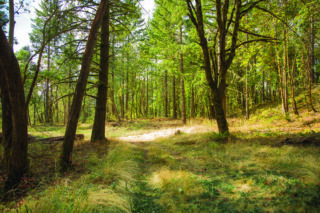
(Photos: Metro)
Imagine rolling your bike onto the MAX, getting off at the end of the Blue Line in Hillsboro, then pedaling 10 miles to some sweet singletrack. That could become reality, but only if you speak up and get involved.
About 23 miles west of Portland — and just 10 miles south of the Hillsboro Transit Center — lies 1,200 acres of undeveloped land called the Chehalem Ridge Nature Park. Before the economy tanked it was prepped for housing, but Metro purchased it in 2010 with funds from their Natural Areas Levy. And we’re lucky they did because it could someday be home to bike trails.
Metro says Chehalem Ridge is one of the largest publicly owned natural areas in Washington County. It’s about the same size as Oxbow Regional Park in east Multnomah County, yet it’s relatively unknown because of its rural location and lack of public facilities. The land itself (based on photos, I have yet to explore it) offers sweeping views of the Tualatin Valley and Coast Range to the west. Its gradual inclines, meadows, and groves of trees give it loads of potential as a place where off-road cycling could flourish.
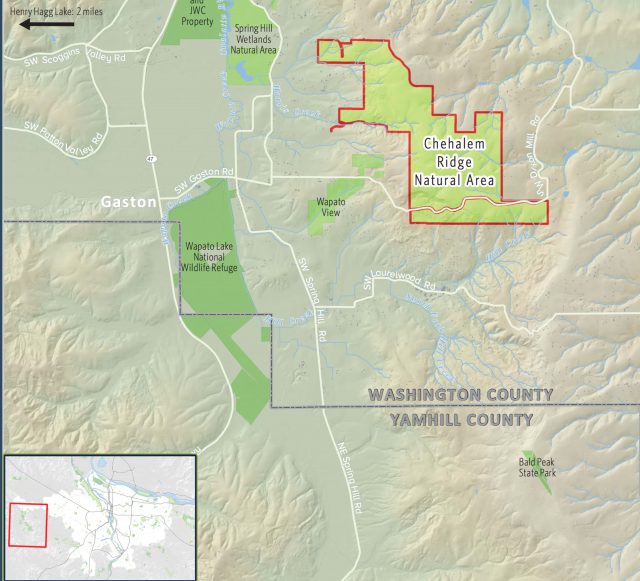
(Map: Metro)
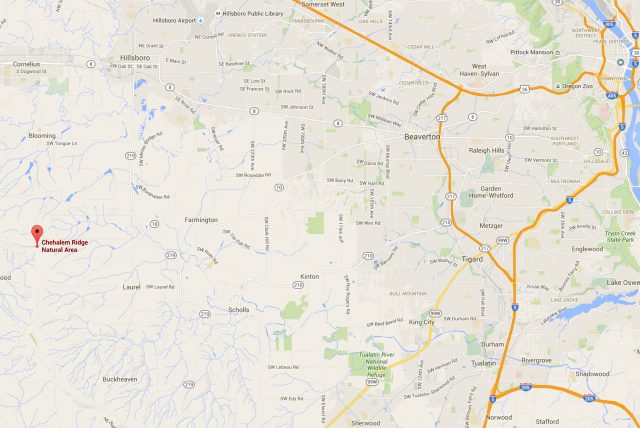
Advertisement
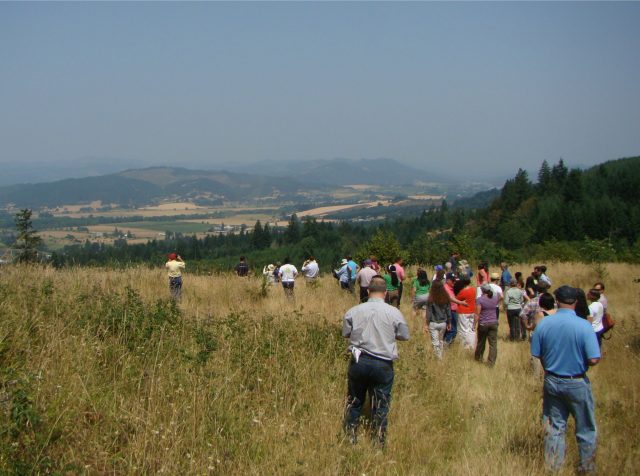
With Metro’s recent support for trails in the North Tualatin Mountains, there’s good reason to hope that Chehalem Ridge could be another, relatively close-in mountain biking destination for our region. But there’s one thing missing so far: Feedback and comments from people who love off-road cycling and want more places to do it.
Similar to how they approached the Tualatin Mountains parcels, Metro says, “What that nature park looks like will be up to community members to shape.” And our source at Metro assures us that “off-road cycling is part of the discussion.”
Now’s the time to take Metro’s Chehalem Ridge Nature Park Master Plan survey and let them know what you want. The last day to respond is this Friday June 10th!
This is an important opportunity to create a fun and accessible new park for all! Please take the survey, learn more at OregonMetro.gov, and stay tuned to BikePortland for more opportunities to weigh in.
— Jonathan Maus, (503) 706-8804 – jonathan@bikeportland.org
Our work is supported by subscribers. Please become one today.


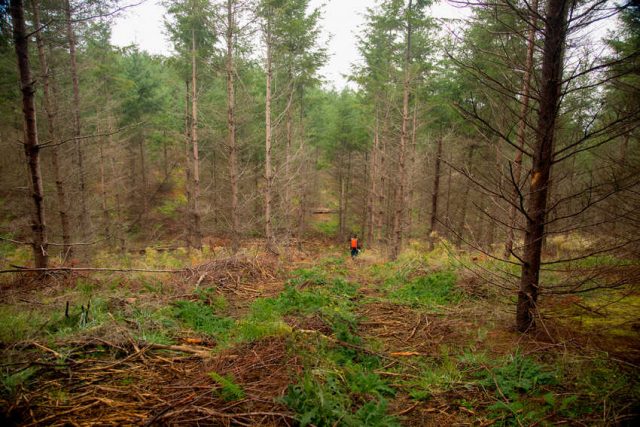
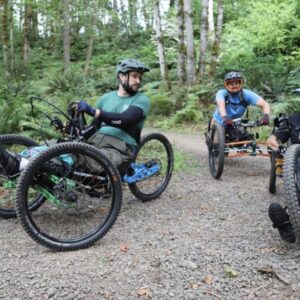



Thanks for reading.
BikePortland has served this community with independent community journalism since 2005. We rely on subscriptions from readers like you to survive. Your financial support is vital in keeping this valuable resource alive and well.
Please subscribe today to strengthen and expand our work.
I’ve been hiking in that parcel a few times & rode through it on the fire roads on my road bike. Most of it is densely-planted tree farm. Eerie quiet, row after row of identical Doug Fir.
It is *ideally* located for a Stubb Stewart type MTB+campground facility. You could ride to it on side roads from the westside burbs in an hour or so. The terrain is great for trails, and you’re just over Chehalem ridge from wine country.
I just sent this in:
–
I strongly believe that the more kids we get outdoors in natural places, the better protected those places will be in the long term. Also, the greater the constituency for natural areas, the more enthusiasm this community will have for restoring impacted areas (like Chehalem Ridge) to a more natural state. That’s why I’m a big supporter of mountain bike access. I hike more than I ride, but I’ve seen first hand how excited young people can be about being able to ride their bikes in natural places. Giving kids a place to ride on dirt paths in the woods lets them get away from cars, concrete, and even from drugs and youthful, risky behaviors.
–
While some might say “those kids are welcome to come hiking here, but they shouldn’t be allowed to ride bikes,” I argue that we need as many possible avenues to attract the next generation of conservation voters. I’ve been hiking and loving it since I was a child, but some kids don’t like hiking! Anyone who has children will understand, of course, that different kids have different interests: it’s why schools offer such varied extra-curricular activities as wrestling and football, French Club and orchestra. If our wild places are a hikers-only attempt at one-size-fits-all, we will be excluding many, many youth.
–
The cost of this access is low. There is little environmental or financial risk, and much social and environmental benefit. I know that a lot of environmentalists disagree with me, but I have yet to see a scientific study showing cyclists have greater impact than hikers in terms of wildlife, soil erosion, or plant health (just look at the studies done by land managers like the National Park Service and New Zealand’s Department of Conservation). Furthermore, the claims that bicycle use make the trails “unsafe” for hikers is belied by the fact that hikers and cyclists co-exist quite well across our region. For example, hiking and cycling are the dominant uses of the Leif Erickson Trail in Forest Park and of trails in Powell Butte Natural Area. If cycling were as dangerous or threatening as these critics contend, why is the Leif Erickson Trail so popular with joggers and dog walkers, and why is the parking lot at Powell Butte full of cars driven by hikers on every sunny afternoon?
–
In regards to Forest Park, critics of cyclists said both that the Northern part of the Park was too natural, too pristine, too un-trafficked, for bike access *and* that the Southern part of the Park was too busy with hikers for bikes to be allowed! It is not merely convenient that this analysis would leave nowhere to ride: it is a case of cherry-picking the facts to fit the desired solution. To me, this shows that much of the ill-will held against cyclists is emotional in nature, and not based in science. Don’t get me wrong: all feelings are valid, and I can’t blame someone for not liking seeing a person ride a bicycle on a path in the woods. But not all feelings are a rational basis for public policy decisions regarding land management.
–
I know Metro will get pushback if bikes are to be allowed at Chehalem Ridge. I was deeply disappointed when Metro’s excellent plan for the North Tualatin Mountains Access Plan was changed, at last minute, to better suit the desires of a property developer who owns property in the area, resulting in a loss of planned trail mileage. I was incredulous that the public process could be disrupted and bent to private desires so easily, and I expect something like that will happen at Chehalem Ridge, too. I just beg of you, in your planning process, to resist the calls to create a plan that benefits only a few, and only narrower interests. I ask you to think of the good of many, and especially of the next generation of conservation voters. Who will that next generation be? What will they look like? How can land managers welcome them and encourage them to visit, love, and support regional wild areas? These are big questions; the answers will help determine how we tackle the real challenges to our natural areas, like climate change, sprawl, and resource extraction. Let’s get those kids outdoors on foot, on horseback, on bike.
Yes to this! I’ve passed by this park on a couple rides over the Chehalem Ridge. The Ridge itself is a secret treasure, full of fairly quiet (but fairly steep) gravel roads leading up to the top. With the popularity of “gravel grinding”, I’m surprised it isn’t as much of a destination as other places. (Or maybe it’s secret and I’m not supposed to talk about it? 😉 )
What would REALLY be nice would be some sort of primitive hiker/biker or “hike-in” campsite on this park. All it would really need is a few campsites, a pit toilet or three, and a water pump. (And be a bit off the road.) It’s a shame that Oxbow (or Dodge Park, though that’s a City of Portland facility) has no special provisions for bike campers. A campsite at Chehalem Ridge wouldn’t make up for it, but it would be a nice destination in itself along with MTB trails, or a stop over for a ride out to the Coast via the Nestucca River or up the Willamette Valley.
And yes Jonathan, you should get out and explore this area! 😉
Hello out there! It’s called the Chelahem Ridge NATURE PARK. A place to go for peace and quiet. A place for wildlife. Not for jacked up yahoos on mountain bikes turning it into their version of an urban skateboard park. Next, the ATV crowd will want in too!
Hello mike!
I haven’t seen anyone say it should be opened for yahoos of any kind. There’s nothing about an urban nature park that’s inherently incompatible with a non-motorized vehicle with rubber tires operated with care and precision for land and other animals.
And yet as soon as you let in MTBs it no longer is a nature preserve, it’s another place for people to turn into a human place. Why not leave it alone and let the animals who live there now be in peace? Does everything have to be full of humans? And bikes? And, of course, parking lots and camp grounds? I live near the Chehalem Ridge and bike through there on the road a few times a month. Camp grounds, parking lots, trails for bikes will ruin it as a nature preserve.
The arrogance of having to have every nature preserve a place for humans to do non-nature-related sports is incredible.
You know what? Sure. No MTBs there. Let’s allow them in Forest Park instead. Works for me.
Actually, yes that would be the right choice. FP is the ideal park- urban(ish), established, stable. When CR gets to the point that we know nonhuman populations can handle people then fine, ride away. Until then, let’s give it time.
Ugghh. Spare me the hypocrisy. You ride a bike through there yourself a few times a month and you’re giving us a hard time because we’d like to do the same?! Have you stopped to think about the environmental impact of the paved or gravel road you apparently enjoy riding, versus the impact of a narrow ribbon of dirt that we like riding? Are you so innocent? How would you feel if riding lonely paved or gravel roads was banned? I can’t even believe you mentioned this, because it puts the hypocrisy so out in front, I even wonder if you’re being serious.
–
This fantasy that someone riding a bike can turn a wild place or even a wilderness into a theme park (or, as you say, a “human place) is out of control. Have you ever visited the McKenzie River, or the North Umpqua Trail, or the Plains of Abraham? These are wild places that hikers rave about! They’re all open to bikes. A person riding a bicycle on a path in wild woods does not destroy those woods or their character. That’s a feeling your have in your head, and while all feelings are valid, not all feelings are a useful guides for public policy. You’re welcome to feel that way, but I don’t think that gives you a right to diminish the park for a whole class of people.
–
And, in case you haven’t noticed on your apparently pure and innocent bike rides through this area already, it’s a human place. Douglas Fir plantations, old cattle fields. . . these are impacted landscapes (heck, given the fire control regime that the local First People practiced, it’s a given, in ecological circles, that the entire Willamette Valley was a “human place,” though the natives had the sense to garden the valley in a highly sustainable, productive way).
Big difference between riding the road through the area on a road and making trails.
It is Bike “Portland” lets see what you can do for Portland and Forest Park before you head out to Washington County with all these great plans. Based on the comment about Wash Co on this site, who would want to come out here anyway?
Yea, the difference is that building a road is much more disruptive than trails.
the road has far more impact on nature than a trail.
Yeah, that road blocks migrating species, opens up an avenue for tail pipe, noise pollution, light pollution, increased erosion. . . shall I go on?
Oh, so it’s cool for YOU to be in there but bad for OTHERS to be there. That sounds about right.
No, the arrogance and power of the all-powerful hiking clubs in shutting down mountain biking EVERYWHERE we try is what’s incredible.
I don’t know why anyone bothers engaging with Mike anymore. It’s completely unproductive and only provides value to him.
Good point. If the ATV’s get access the monster trucks will be next in line. Next thing you know, Evil Knievel is jumping 40 school buses back to back! Where will it end?
It’s called a “Nature Park”, because it isn’t a manicured, suburban lawn and of park (eg Laurelhurst Park, Grant Park). It’s a area with relatively natural vegetation, used for human recreation, like Powell Butte – which has many trails for bikes.
Can someone please tell me why Mike’s comments are allowed here? They’re always filled with direct insults.
Because it’s kinda fun to watch, like Sideshow Bob is. http://youtu.be/0w6L93kD3xw
I don’t see why you would feel insulted unless you are a jacked up yahoo on a mountain bike.
You’re wrong. It’s not called “Chelahem Ridge NATURE PARK.”
People have effects on wildlife period. The Chehalem Ridge Nature Park will have human access. I take offense to your stereotypes and insulting labeling. I ride my bike to get into nature, not destroy it.
Ah yes, the old slippery slope argument, lumping bicycles in with noisy, polluting ATVs again.
Are you one of those people that sees the word “natural” on a product label and assume that automatically means the product is good for you? It’s only called nature park because that’s what metro decided to call it when they used our tax dollars to purchase it.
Nature does not equal wilderness.
Yes. Because “The ATV crowd” has nowhere to ride. At all.
I think every mountain biker in Portland has survey fatigue. Yes, fill out another one please.
I’m a hiker, not a mountain biker (just a mountain bike sympathizer) so I filled this one out, taking one for the shared-access to the outdoors team!
But honestly, as an observer – it looks to me like politely coloring within the lines is not getting the NWTA very far. I wonder if Portland mountain bikers should consider adding peaceful protest to their political toolkit?
They have done this. Look up the RVNA protest – over 300 people showed.
Oh good! I missed that, thanks!
I’m looking forward to hearing from the neighbors who live nearby.
“…Similar to how they approached the Tualatin Mountains parcels, Metro says, “What that nature park looks like will be up to community members to shape.” And our source at Metro assures us that “off-road cycling is part of the discussion.” …” bikeportland
Whom Metro regards to as community members relative to decisions made about future use of this particular parkland, would be helpful to know. The area in which the land sits, is largely rural, compared to the heavily urban and suburban area adjacent to Forest Park. Population is growing though, in nearby Forest Grove and Hillsboro. That’s people that will be looking for and needing opportunities for outdoor experiences in natural settings. What range of such experiences they’d like to have available, and how close to where they live it would be beneficial have such opportunities available, are important questions, it seems to me. So…what will they want from this parkland, and how will they expect it to conserved and used?
On the road bike, I’ve ridden through the park…technically; SW Dixon Mill Rd, a gravel road, passes through this parkland. The road is a road in every sense, rather than a trail, or trail designed to be used for mountain biking. The road can be used with motor vehicles, and there is some of that, but not a lot at present. It’s a nice area, very quiet. Again…with a growing population, the area could come to see more traffic and become less quiet than it is now.
This land has been parkland for six years. This weblog, bikeportland, has done stories about it in past, and maybe a few stories from the Oregonian as well. Since I became aware of this parkland, years back, I’ve wondered what level of interest there may be, of this land being used for mountain biking. Outside of limited discussions on this weblog, arising from bikeportland’s periodic stories about mountain biking, it’s difficult to know how much interest, local to the park, and Metro wide, there may be in using Chehalem Ridge Nature Park for mountain biking.
Were for example, Metro to propose to voters, to buy a parcel of natural land specifically, though not necessarily exclusively for mountain biking, the level of interest and how widespread interest in that activity in the valley is, may have been much clearer than it seems to be at present.
From Forest Grove to Gaston, south on Hwy 47, it’s a nice drive, and a decent bike ride on the road’s exceptionally wide shoulders. Dixon Mill Rd is a really fine ride. Riding gravel is gaining popularity and acceptance, so that road surface isn’t much of a problem for using this park, at least at present. So it’s kind of a ‘wait and see’ to learn by various means, from the community, whatever that is considered to be, what interest there is in using this park for mountain biking.
Don’t provide parking.
The formula is actually much simpler than people realize. If you have to walk or ride there (and up the hill), only nice people will come who respect the land. People who think they’re not being invasive to nature by driving their cars to a ‘natural area’ boundary are severely deluded.
How much wildlife dies each day on the streets of Portland?
Among other casualties.
Just another sign of our misguided society that it is a given that roads themselves aren’t in the discussion about negative environmental impacts. It’s insane.
The Forest Park Conservancy might not be aware that Germantown and Cornell go through FP.
ATTENTION PLEASE:
I live right next to the Chehalem Ridge Natural Area. I’m a transplant to Gaston a couple of years ago, moving from Belmont are of SEPDX, where I was a hard core bike commuter (I commute the 20 miles to Hillsboro now by bike…when it’s safe, so WOOF!). I think I can speak on this issue with a broad perspective.
I’ve been to numerous community meetings about Chehalem Ridge. The pulse of the people who live here is that they have these priorities:
1. A quiet place area to hike and observe wildlife
2. No motorized vehicles
3. Horse access.
4. So far, very negative views toward MTBs, mostly because of #1. Justified or not, this is how people feel.
One thing that struck me when I move out here is how LITTLE public space there is. We’re surrounded by natural beauty, rolling hills, little streams, etc, but it’s all privately owned. And people have guns. Chehalem Ridge promises to be a place to wander, contemplate, and connect very deeply with nature.
I’ve hiked there many times and seen lots of deer and birds. I hear coyotes there all the time. I’ve seen bobcat and cougar tracks. There are active, inhabited beaver dams there, people! It’s amazing.
It used to be owned by a lumber company, so lots of the area is monoculture douglas fir. Metro is doing an OUTSTANDING job of thinning these out to provide diverse understory species to grow. They are taking the long view and want this to be a special place for generations. I think if we all think about it carefully and try to steer away from our narrow interests for the place, that we’ll find that we want this, too.
It will probably take YEARS for the plan to be implemented. Also, THE AREA IS CLOSED FOR THE SUMMER due to tree thinning and other rehabilitation work.
Please respect the slow, deliberate process that Metro has begun. They are open to MTBs in dedicated areas. The fastest way to turn locals off to supporting MTB access is to come off like covetous wolves, slavering over access to a new playground, er flock of sheep (sorry to mix metaphors).
Peace,
Ian
1. Luckily for your neighbors, mountain bikes, having no motors, are silent (or, rather as silent as the humans who ride them, just as it is with hiking).
2. That “slow, deliberate process” undertaken by Metro may just work out to the advantage of those who want an open, inclusive trail plan, rather than an exclusive, discriminatory plan. However, several regional planning processes have changed at the very last moment from inclusive to exclusive, (Forest Park, Riverview, and North Tualatin Mountains). Respecting the process is exactly what NWTA and other mountain bike advocates have done. We’ve worked with the City and Metro before. But powerful local interests end up dominating the process, often behind the scenes. Don’t lecture us about respect; it’s the politically connected, property-owning locals who distort the process by throwing around their personal power.
“But powerful local interests end up dominating the process, often behind the scenes. Don’t lecture us about respect; it’s the politically connected, property-owning locals who distort the process by throwing around their personal power.”
@Charley, yeah it often seems like organizers already have their agenda settled by the time they open things up for public input. Makes you feel like you’re in a “Parks and Recreation” episode, eh?
Funny thing, I’m usually one of the only neighbors at these meetings and haven’t really sniffed-out the “powerful local interests” yet. The biggest noise-makers are the equestrians, many of whom have been riding on the trails for years and want to maintain access. Most local people have no idea what’s even happening out here, much less give a hoot about bikes, hikes, etc.